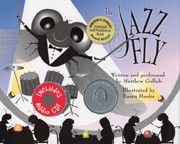Choosing Just the Right Names for Story Characters

Choosing just the right names for your story’s characters sounds like it would be easy enough. Usually, though, it isn’t, at least not for me. In an interview for the National Association for Music Education, the columnist/ editor Tom Amoriello questioned me about that exact challenge. To help students and other writers, I’ll share that exchange. (To check out the whole interview with all of Tom’s inventive questions, click here.)
Tom Amoriello: The friendly characters’ names such as The Jazz Fly, Willie the Worm, Nancy the Gnat, and Sammy the Centipede all have that “name in lights” ring to them. How much time do you put into character names? Do they just come to you? Do you have a “B” and “C” list that did not make the cut?
Matthew Gollub: I’m glad the “name in lights” ring came through! Occasionally, the names of characters just come to me. More often, I need to create lists of possibilities then winnow out the ones that are too long, too hard to say, too hard to read, etc. I didn’t specifically save a “B” or “C” for names. Once I practice chanting a story aloud, I listen for the most evocative names that feel good to say. In general, I write fifteen to twenty drafts of a story, so settling on the right names can take weeks or months!
You can tell I was going for alliteration in naming the bandmates. The name “Sammy the Centipede” repeats the “s” sound but demonstrates that you can spell it with “s” or “c.” “Nancy the Gnat” echoes the “n.” But most kids don’t realize you can spell “n” with “gn.” Creativity is a major theme of The Jazz Fly, so I thought presenting new ways to spell would fit the spirit. I even wrestled with how to spell “Willie,” the worm who “inches up and down” the bass. In early drafts of the manuscript it was spelled “Willy.” But “Willie” seemed hipper and more gender neutral. (Worms are “non-binary,” after all!) And as a kid I would always read about famous athletes like Willie Mays . . .
…So that offers a glimpse into the process of choosing names. Of course, when you’re writing straight prose, and rhymes and meter aren’t an issue, a simple, evocative name may do the trick. With ordinary prose, as opposed to verse, you’d presumably have more chances to distinguish the character through whatever actions and attributes that make them memorable.
Some authors jot their possible character names on Post-its. Then they attach them to a wall or mirror and try “living” with those names for a stretch while working on other aspects of the story. Feeling the need to “test drive” cthe names? Just tap into the marvels of software and choose to substitute one name for the next.



